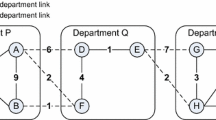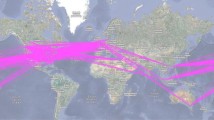Abstract
This study examines the impact of collaborating patterns on the R&D performance of public research institutions (PRIs) in Korea’s science and engineering fields. For the construction of R&D collaborating networks based on the co-authorship data of 127 institutions in Scopus, this paper proposes four types of collaborations by categorizing network analyses into two dimensions: structural positions (density, efficiency, and betweeness centrality) and the relational characteristics of individual nodes (eigenvector and closeness centralities). To explore the research performance by collaboration type, we employ a data envelopment analysis window analysis of a panel of 23 PRIs over a 10-year period. Comparing the R&D productivities of each group, we find that the PRIs of higher productivity adhere to a cohesive networking strategy, retaining intensive relations with their existing partners. The empirical results suggest that excessively cohesive alliances might end up in ‘lock-in’ relations, hindering the exploitation of new opportunities for innovation. These findings are implicit in relation to the Korean Government’s R&D policies on collaborating strategies to produce sustained research results with the advent of the convergence research era.

Similar content being viewed by others
Notes
Refer to Cooper et al. (2011) for further DEA models.
Scopus is the largest abstract and citation database containing both peer-reviewed research literature and quality web sources, offering 18,500 titles from more than 5,000 international publishers as of April 2011. All Korean PRIs are registered as affiliations.
See Appendix 2 for the centrality calculation formula.
A high level of appropriateness was found when the ALSCAL method of SPSS v.14 was applied, with S-stress standing at 0.18 and RSQ at 0.95.
References
Adler, N., & Raveh, A. (2008). Presenting DEA graphically. Omega, 36(5), 715–729. doi:10.1016/j.omega.2006.02.006.
Ahuja, G. (2000). Collaboration networks, structural holes, and innovation: A longitudinal study. Administrative Science Quarterly, 45(3), 425–455.
Allen, T. J. (1970). Communication networks in R & D laboratories. R&D Management, 1(1), 14–21.
Banker, R., Charnes, A., & Cooper, W. (1984). Some models for estimating technical and scale inefficiencies in data envelopment analysis. Management Science, 30(9), 1078–1092.
Banwet, D., & Deshmukh, S. (2008). Evaluating performance of national R&D organizations using integrated DEA-AHP technique. International Journal of Productivity and Performance Management, 57(5), 370–388.
Barabasi, A. L., Jeong, H., Neda, Z., Ravasz, E., Schubert, A., & Vicsek, T. (2002). Evolution of the social network of scientific collaborations. Physica A: Statistical Mechanics and its Applications, 311(3–4), 590–614.
Bozeman, B., & Corley, E. (2004). Scientists’ collaboration strategies: Implications for scientific and technical human capital. Research Policy, 33(4), 599–616.
Brown, M., & Svenson, R. (1998). Measuring RD productivity. Research-Technology Management, 41(6), 30–35.
Burt, R. S. (1992). Structural holes. Cambridge, MA: Harvard University Press.
Charnes, A., Cooper, W. W., & Rhodes, E. (1978). Measuring the efficiency of decision making units. European Journal of Operational Research, 2(6), 429–444.
Choi, Y. (2003). Evolution of science and technology policy in Korea (Vol. 3). Korea: Science and Technology Policy Institute.
Coccia, M. (2004). New models for measuring the R&D performance and identifying the productivity of public research institutes. R&D Management, 34, 267–280.
Coccia, M. (2005). A scientometric model for the assessment of scientific research performance within public institutes. Scientometrics, 65(3), 307–321.
Cooper, W. W., Seiford, L. M., & Tone, K. (2007). Data envelopment analysis: A comprehensive text with models, applications, references and DEA-solver software. New York: Springer.
Cooper, W. W., Seiford, L. M., & Zhu, J. (2011). Data envelopment analysis: History, models, and interpretations. In Handbook on data envelopment analysis (Vol. 164, pp. 1–39). International series in operations research & management science. US: Springer.
Defazio, D., Lockett, A., & Wright, M. (2009). Funding incentives, collaborative dynamics and scientific productivity: Evidence from the EU framework program. Research Policy, 38(2), 293–305. doi:10.1016/j.respol.2008.11.008.
Esposti, R., & Pierani, P. (2003). Building the knowledge stock: Lags, depreciation, and uncertainty in R&D investment and link with productivity growth. Journal of Productivity Analysis, 19(1), 33–58.
Etzkowitz, H., & Leydesdorff, L. (2000). The dynamics of innovation: From national systems and “Mode 2” to a Triple Helix of university–industry–government relations. Research Policy, 29(2), 109–123.
Geisler, E. (1995). An integrated cost-performance model of research and development evaluation. Omega, 23(3), 281–294.
Griliches, Z. (1990). Patent statistics as economic indicators: A survey. Journal of Economic Literature, 28(4), 1661–1707.
Hashimoto, A., & Haneda, S. (2008). Measuring the change in R&D efficiency of the Japanese pharmaceutical industry. Research Policy, 37(10), 1829–1836.
He, Z.-L., Geng, X.-S., & Campbell-Hunt, C. (2009). Research collaboration and research output: A longitudinal study of 65 biomedical scientists in a New Zealand university. Research Policy, 38(2), 306–317. doi:10.1016/j.respol.2008.11.011.
Jiménez-Sáez, F., Zabala-Iturriagagoitia, J. M., Zofío, J. L., & Castro-Martínez, E. (2011). Evaluating research efficiency within national R&D programmes. Research Policy, 40(2), 230–241. doi:10.1016/j.respol.2010.10.005.
Kastelle, T., & Steen, J. (2010). Are small world networks always good for innovation? Innovation: Management, Policy & Practice, 12(1), 75–87.
Katz, J. S., & Martin, B. R. (1997). What is research collaboration? Research Policy, 26(1), 1–18.
Kerssens-van Drongelen, I., & Bilderbeek, J. (1999). R&D performance measurement: More than choosing a set of metrics. R&D Management, 29, 1.
Kerssens-van Drongelen, I., & de Weerd-Nederhof, P. (2010). The use of performance measurement tools for balancing short- and long-term NPD performances. International Journal of Innovation Management, 2, 54.
Kogut, B. (2000). The network as knowledge: Generative rules and the emergence of structure. Strategic Management Journal, 21(3), 405–425.
Koka, B. R., & Prescott, J. E. (2008). Designing alliance networks: The influence of network position, environmental change, and strategy on firm performance. Strategic Management Journal, 29(6), 639–661.
Lee, H., Park, Y., & Choi, H. (2009). Comparative evaluation of performance of national R&D programs with heterogeneous objectives: A DEA approach. European Journal of Operational Research, 196(3), 847–855.
Liberman, S., & Olmedo, R. L. (2008). Scientist’s semantic meaning of the concept of coauthorship. In Fourth international conference on webometrics, informetrics and scientometrics and ninth COLLNET meeting, Berlin.
MOST (2009). Korean science and technology fact book 2009. Ministry of Science and Technology.
Mote, J. (2005). R&D ecology: Using 2-mode network analysis to explore complexity in R&D environments. Journal of Engineering and Technology Management, 22(1–2), 93–111. doi:10.1016/j.jengtecman.2004.11.004.
Mote, J. E., Jordan, G., Hage, J., & Whitestone, Y. (2007). New directions in the use of network analysis in research and product development evaluation. Research Evaluation, 16(3), 191–203.
Newman, M. E. (2001). The structure of scientific collaboration networks. Research support, non-U.S. Government research support, U.S. Government, non-P.H.S. Proceedings of the National Academic of Science USA, 98(2), 404–409. doi:10.1073/pnas.021544898.
Newman, M. E. (2004). Coauthorship networks and patterns of scientific collaboration. Research support, non-U.S. Government research support, U.S. Government, non-P.H.S. Proceedings of the National Academic of Science USA, 101(Suppl 1), 5200–5205. doi:10.1073/pnas.0307545100.
Padula, G. (2008). Enhancing the innovation performance of firms by balancing cohesiveness and bridging ties. Long Range Planning, 41(4), 395–419.
Park, H. W., Hong, H. D., & Leydesdorff, L. (2005). A comparison of the knowledge-based innovation systems in the economies of South Korea and the Netherlands using triple helix indicators. Scientometrics, 65(1), 3–27.
Porac, J. F., Wade, J. B., Fischer, H. M., Brown, J., Kanfer, A., & Bowker, G. (2004). Human capital heterogeneity, collaborative relationships, and publication patterns in a multidisciplinary scientific alliance: A comparative case study of two scientific teams. Research Policy, 33(4), 661–678. doi:10.1016/j.respol.2004.01.007.
Reagans, R., & Zuckerman, E. W. (2001). Networks, diversity, and productivity: The social capital of corporate R&D teams. Organization Science, 12(4), 502–517.
Rigby, J., & Edler, J. (2005). Peering inside research networks: Some observations on the effect of the intensity of collaboration on the variability of research quality. Research Policy, 34(6), 784–794. doi:10.1016/j.respol.2005.02.004.
Schilling, M., & Phelps, C. (2007). Interfirm collaboration networks: The impact of large-scale network structure on firm innovation. Management Science, 53(7), 1113–1126.
Sena, V. (2004). Total factor productivity and the spillover hypothesis: Some new evidence. International Journal of Production Economics, 92(1), 31–42.
Sueyoshi, T. (1992). Measuring technical, allocative and overall efficiencies using a DEA algorithm. Journal of the Operational Research Society, 43(2), 141–155.
Tangen, S. (2004). Performance measurement: From philosophy to practice. International Journal of Productivity and Performance Management, 53, 726–737.
Tsekouras, K., Pantzios, C., & Karagiannis, G. (2004). Malmquist productivity index estimation with zero-value variables: The case of Greek prefectural training councils. International Journal of Production Economics, 89(1), 95–106.
Van der Valk, T., & Gijsbers, G. (2010). The use of social network analysis in innovation studies: Mapping actors and technologies. Innovation: Management, Policy & Practice, 12(1), 5–17.
Acknowledgments
The authors acknowledge that this work was supported by the National Research Foundation of Korea Grant funded by the Korean Government (NRF-2011-330-B00046).
Author information
Authors and Affiliations
Corresponding author
Appendices
Appendix 1
See Table 4.
Appendix 2
Closeness centrality
If the shortest distance of the path linking two nodes i and j is d ij , the closeness centrality of node i can be written as \( C_{i} = \left[ {\sum\nolimits_{j = 1}^{n} {d_{ij} } } \right]^{ - 1} \).
Node betweeness centrality
When g jk is the number of the shortest paths existing between two certain nodes (j, k) and g jk (i), the number of stops at i as a point existing between the points j and k, the node betweeness centrality of node i is: \( C_{i} = \sum\nolimits_{j < k} {g_{jk} (i)} /g_{jk} \).
Eigenvector centrality
When C j is the centrality of node j, a ij the intensity of the relation between i and j, and λ the biggest eigenvector value for the relation matrix between i and j, the eigenvector centrality of node i is expressed as follows: \( C_{i} = \frac{1}{\lambda }\sum\nolimits_{j = 1}^{n} {a_{ij} } C_{j} \).
Rights and permissions
About this article
Cite this article
Lee, D.H., Seo, I.W., Choe, H.C. et al. Collaboration network patterns and research performance: the case of Korean public research institutions. Scientometrics 91, 925–942 (2012). https://doi.org/10.1007/s11192-011-0602-8
Received:
Published:
Issue Date:
DOI: https://doi.org/10.1007/s11192-011-0602-8




